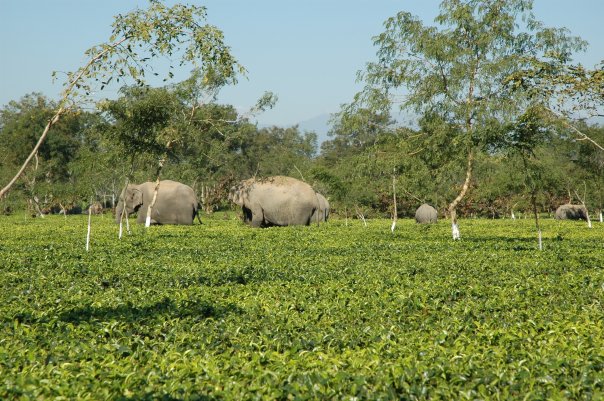
Assam is prime elephant country. It’s a land of big rivers, dense bamboo groves, rain forests with long, drooping moss and startling orchids. In the jungle clearings, elephant grass shoots up to over 10-feet to shelter a teeming wildlife. Assam Tea–the finest tea on earth– chooses to grow in this wild terrain and nowhere else. Not surprisingly “elephant trouble” a frequent complaint in the tea plantations.
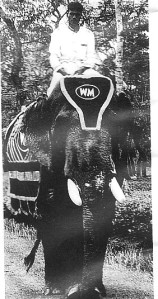
Every tea planter has a plethora of elephant stories and I have a few of my own. When I seven, a semi-domesticated elephant grabbed me by the ankle and almost got me but luckily I was yanked back by a nearby adult. I still have bad dreams about that one! Another time a baby elephant came floating down the flooded Koilapani River. For two weeks he lived in the taro patch behind our bungalow and played peek-a-boo with a hen before he was shunted off to Calcutta zoo, much to our heartbreak.
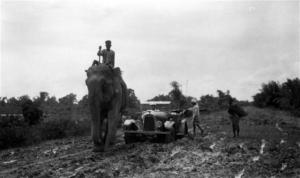
Along with owning their tractors, trucks and trailers, most tea gardens own an elephant or two. Domesticated elephants are invaluable to the tea industry. They are trained by special elephant trainers called mahouts. Elephants render a multitude of services that range from forest logging to rescue missions for tea garden residents stranded in the flood. Assam is the wettest place on earth. The monsoons hit with a fury each year; rivers overflow, bridges collapse and tea plantations are marooned for weeks without power or supplies. Elephants are called to the rescue when river currents get too strong for a boat. 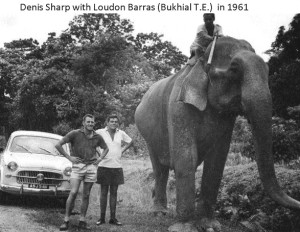 My favorite story is about my Aunt Baruna who dropped her high-heeled slipper in the floodwaters when she crossing on elephant back to get to the gala at the Planter’s Club. All evening she hobbled on one shoe while standing tiptoe on the other foot and nobody could tell anything was amiss under her long saree!
My favorite story is about my Aunt Baruna who dropped her high-heeled slipper in the floodwaters when she crossing on elephant back to get to the gala at the Planter’s Club. All evening she hobbled on one shoe while standing tiptoe on the other foot and nobody could tell anything was amiss under her long saree!

Tea garden kids are the envy of their friends. Town kids have puppies and kittens but guess what we had as pets? Monkeys, elephants and the occasional leopard cub! On birthdays and special occasions the garden elephant made a grand appearance to give us kiddies fun rides. Old Jumbo also showed up all tinsel-decked at the Club Christmas party with (an often slightly inebriated) Santa perched on top.

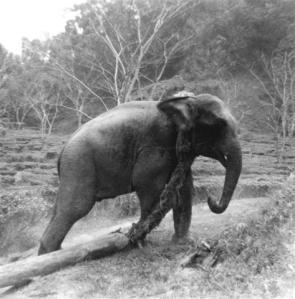
Elephants are useful during shikar (hunting) to track down game, mostly man-eating leopards and tigers that prowl the tea plantations to prey on humans.
Elephants in herds are usually harmless but they can create plenty of damage. A herd of elephants often invaded the sugarcane patch behind our bungalow and had to be chased out with lighted torches and the beating of tin cans. I still remember the sound of their wild trumpeting in the night: it is the most eerie, bone-rattling sound on earth!

Encountering a rogue elephant in the wild is very bad news. Rogue elephants can destroy everything in their path with mindless fury. There is the horrific incident of a local postman who was cycling through the jungle road to a tea garden when he came face-to-face with a rogue. The elephant picked him by the feet and smashed him into a tree and (this is really gross) the poor man had to picked off the bark like putty. That is the fury of a rogue.
With increasing deforestation in Assam, elephant problems in the tea gardens continue to be on the rise. Here is a National Geographic article about Elephant problems in Assam. Please share your elephant story, if you have one. Thanks and cheers!
Other related articles: The Story of the Elephant Boy of Tea
________________________________________________________________
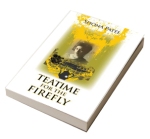 Teatime for the Firefly is Shona Patel’s debut novel. It is a love story set in a remote tea plantation in Assam, India. You can read the SYNOPSIS and the FIRST CHAPTER by clicking on the red links. Shona Patel is represented by April Eberhardt Literary.
Teatime for the Firefly is Shona Patel’s debut novel. It is a love story set in a remote tea plantation in Assam, India. You can read the SYNOPSIS and the FIRST CHAPTER by clicking on the red links. Shona Patel is represented by April Eberhardt Literary.
Very interesting, I’ve never imagined how it was for the kids growing up with these kind of pets, cool.
LikeLike
Indeed! A tea garden childhood sure had it’s perks! Cheers!
LikeLike
Shona, i understand in a different way why there were elephants on one of those tea cups (in your last post). Wonder if that was intentional, or if it as just for aesthetics?
Hope you have a lovely weekend. My only elephant story is the dumbo ride at Disney World. I was so tiny back then.
LikeLike
I have always felt elephants and tea go together. Dumbo rides at Disney are a treat. No wonder kids love elephants! Happy weekend to you too, Trinidad friend!
LikeLike
Lucky you getting away from that half-trained elephant. We were once pursued by a rogue male elephant in Manas – most terrifying experience of my life. The forest guard with us shot at the elephant’s feet and somehow managed to stop him. Gentle giants they maybe, but I am always wary when I am near one.
LikeLike
Funnily, we got chased by a rogue in Manas too! We were in a jeep and the driver had to drive in reverse gear through those rutted jungles road at an unimaginable speed with us all screaming in the backseat. The elephant was so close we could hear his ears flapping. That was horrific. I know exactly what you are talking about. Many thanks for your sharing!
LikeLike
I adore elephants, Shona, so I really enjoyed this post!
When I was about twelve years old I was visiting a zoo with my parents and a baby elephant wrapped his truck around my middle and picked me up. It felt like my father’s arm around my waist, so I had no idea it was an elephant until I saw my dad standing beside my mother. Then I panicked and so did the baby elephant. He dropped me and ran away. I felt really bad for scaring him, after my heart stopped pounding.
LikeLike
That’s a real cute story. Thanks for sharing!
LikeLike
Pet elephants?! I grew up in the wrong country, obviously. Such beautiful animals, and I love the idea of being able to sit on an elephant, that would be a truly magical childhood experiene (or, indeed, adulthood). I wish I had an elephant story but all I can think of is a rather feeble game of ‘I Spy’ I had with a friend one day. He said “I spy with my little eye, something beginning with ‘L'” and the answer was ‘L’-ephant.
LikeLike
Ha ha – “L” for elephant – I love it! My Indian friend’s wee daughter had just learned her English alphabets and I heard her spelling. “A for Pipra” (Pipra is ant in Bengali) and so on all the way to “Z” – she kept substituting the Bengali word by looking at the pictures!
LikeLike
That’s brilliant! Obviously a highly intelligent child.
LikeLike
Very interesting! I’d be curious to know more information about the use of trained elephants for flood rescue missions in Assam. Do you know where I could read more about this (or someone to talk to)?
LikeLike
I don’t have any specific source per se. What I have gathered is collective info from tea planters and my own, Elephant rescue in Assam floods is very common. You could try directing your question to the editor at http://www.koihai.com. His name is David Aire and he is very helpful. Koihai is a website of ex Assam tea planters. I will also put some other feelers out. Good luck! What is it for, may I ask?
LikeLike
Thank you for the very helpful reply. I find elephants fascinating, and in particular the various ways people have traditionally established a productive relationship with them. I knew about logging elephants, but flood rescue elephants I had not heard about until now.
LikeLike